2nd Quarter Newsletter 2025
for the Leavenworth Nutcracker Museum
This page is best viewed on a PC or tablet.
NUTCRACKERS OF FAITH ON DISPLAY IN THE MUSEUM
|
|
|
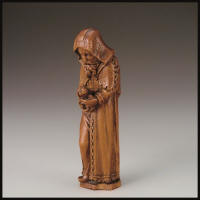 |
This Monk with
Lamb is the favorite nutcracker of Michael McIvor, the talented
graphic artist who brought text and photos together for our
prize-winning Art & Character book.
He admired the carver’s work as enlarging the picture 5 times
only enhanced the beauty of the stipple detailing in the cape and
hood. The nutcracker is
carved of boxwood, the favorite of master carvers.
|
| |
|
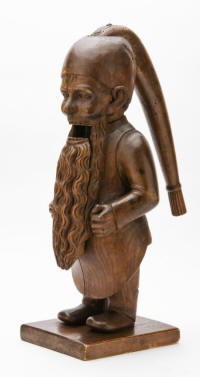 |
The Cellar Friar of the Monastery is
an expert vintner. An
unusual mechanism makes the front jaw slide down as the long tassel
of the hood is raised upward.
After the nut is placed, the tassel is lowered which raises
the front jaw to crack the nut.
This is from Germany, mid-19th century.
It is made of conifer and measures 20 inches in height.
This is one of the few antique nutcrackers
that can accommodate a large walnut.
|
| |
|
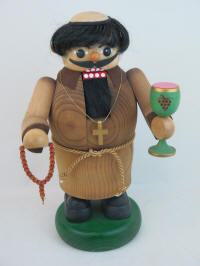 |
Many vineyards and wineries have been
operated by monks, the oldest being at Karthauserhof in Germany
which has been in operation since 1335 when the Carthusean monks
were given a large parcel of land.
This nutcracker was crafted in the workshops
of Richard Glaesser of Seiffen and shows the ‘tonsure’ hair
treatment that has a circular shaved top of the head surrounded by a
ring of hair.
|
| |
|
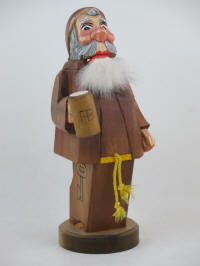 |
This Monk was crafted by Johanne Weih
of Germany, but when the Russians had control, the name became VEB
Rhoenkunst. The name
changed again to JoWeih when Germany regained its independence.
The nutcracker represents a monk from one of the many
monasteries that brewed its own beer.
The oldest of these is Weihenstephan, located in the Bavarian
city of Freising, founded in 1040.
Not only is the beer brewed for their consumption, but it is
sold to support the monastery. |
| |
|
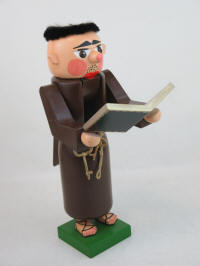 |
Many
books are read and studied in the libraries of the
monasteries, and many books are written there.
Although most are of a
religious theme, both fiction and non-fiction books are written on
many subjects, including such things as the training of puppies.
This nutcracker was created by Eberhard
Roscher from Deutchneudorf, Germany, near the border of the Czech
Republic. He used a
lathe powered by a centuries old water wheel when making his
nutcrackers.
|
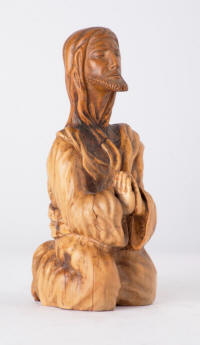 |
In Prayer
is one of the most precious of the museum nutcrackers, and was
created in Italy, circa 1870.
It is made of hammerwood, a light-colored wood in the
consistency of ebony and does not float.
Religious leaders have commented on this as being the perfect
vision of prayer itself.
This nutcracker has an unusual opening as the head falls
backward to display a cavity in which the nut is cracked..
|
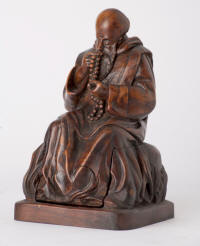 |
This Monk with Rosary, dressed in
typical hooded robe, was carved in Italy in the 19th
century, and breaks the nutshell by sitting on it.
Various forms of the rosary have been developed since the 3rd
century. Christians use
the rosary to count the number of different prayers or the
number of times a certain prayer has been repeated.
People from
every walk of life and ethnic background pray the Rosary.
Most are Catholic, but some are Protestant or Evangelical
Christians. |
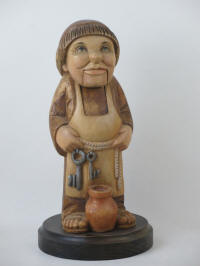 |
This nutcracker was crafted by an
unknown carver in Spain, in the late 20th century, and
depicts a Monk
sequestered in a monastery. Since monasteries were intended to be
self-sufficient, all monks, in addition to their religious study and
work, had responsible duties in caring for their home, their land,
as well as producing food and supplying water for their needs.
They also provided needs for travelers and sick people who
lived near. This sturdy
nutcracker stands at 14.5 inches tall and weighs a hefty 4.5 pounds. |
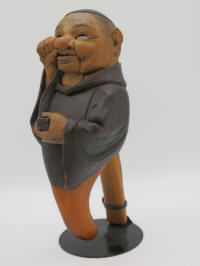 |
This Anri Monk was carved in the
Groeden Valley of Northern Italy.
Anri carvers were known for their artistic nativities, but
from the end of the 19th century to about 1930 they
included a group of nutcrackers.
These figures were carved from Cembra Pine that grew in this
mountainous area, and family members or coworkers were used as
models. This Monk
carries a little box used for tobacco or scented oils. |
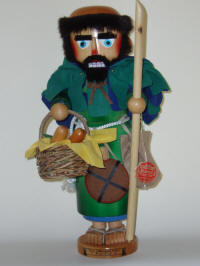 |
Of course,
Friar Tuck gets a lot of
attention. He is
described as a jovial fat priest who loves food and ale.
He spent much of his time with Robin Hood, and his job was to
distribute goods and money to the poor—that which Robin Hood and his
band of Merry Men had retrieved from the rich.
Friars are like monks in that they are devoted to a religious
life, but live and work among regular people.
This nutcracker was made by Steinbach in Germany.
|
Here is an interesting bit of wine history from the ‘Tasting Table’ on the
internet:
Almost 1,200 years ago, when the Stavelotians began producing wine,
Charlemagne ruled most of Europe, Vikings were just beginning to explore
western horizons, and the monks at Stavelot Abbey had already been muddling
through life without wine for about 200 years. To remedy the dire situation,
the holy Roman emperor, overseeing the territory in the ninth century,
gifted the monks a parcel of land on the banks of the Mosel River. They
established a vineyard, began making wine, and the rest, as they say, is
history.
Read More:
https://www.tastingtable.com/1579423/oldest-operating-winery-history/
Contact Us
Monday - Saturday 11-5pm
Sunday - 11-4:30pm
We suggest visitors arrive at least 30 minutes before closing.

 Nutcracker
Museum
Nutcracker
Museum









